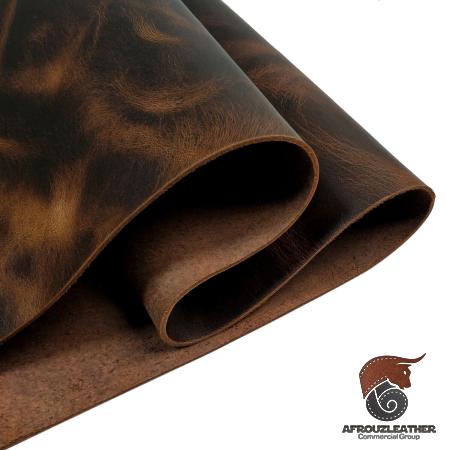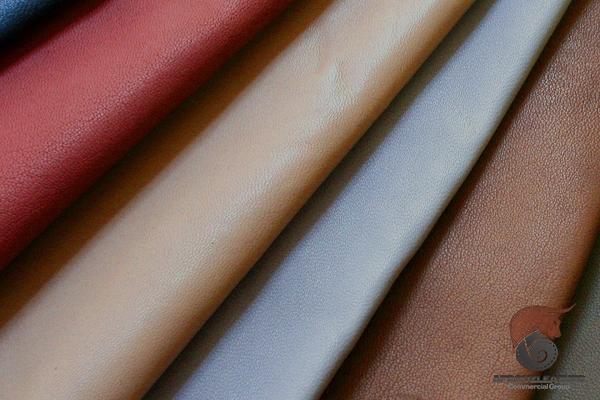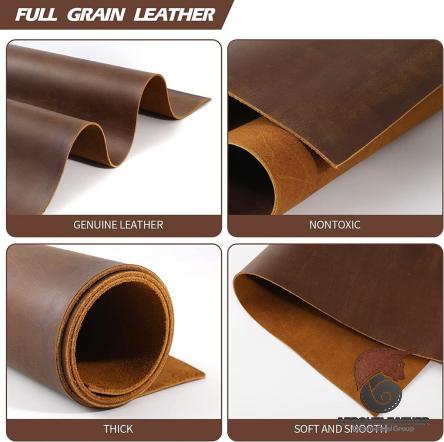Leather has been a sought-after material for centuries for its durability, versatility, and luxurious appeal. As one delves into the realm of leather goods, two popular choices often stand out – lamb leather and cow leather. Both are highly regarded for their quality and are widely used in the fashion and upholstery industries. This article aims to provide a comprehensive comparison between lamb leather and cow leather, shedding light on their characteristics, production processes, uses, and sustainability aspects. Characteristics: Lamb Leather: Lamb leather, derived from young sheep, is known for its softness, supple texture, and lightweight feel. It possesses a fine grain pattern and is particularly well-suited for delicate accessories like gloves, bags, and clothing. Lamb leather has a luxurious appearance and provides excellent drape, making it a popular choice for high fashion garments. Cow Leather: Cow leather, obtained from adult cattle, is renowned for its durability and strength. It exhibits a coarser grain pattern compared to lamb leather and tends to be thicker and heavier. Cow leather is widely used in the production of boots, belts, wallets, and upholstery due to its sturdiness and ability to withstand wear and tear. Production Processes: Lamb Leather: The process of obtaining lamb leather involves carefully selecting hides from young sheep, usually around 6 to 8 months old. These animals are raised primarily for their meat, and their hides are regarded as a byproduct. The hides are first cleaned and then tanned using various methods such as vegetable tanning or chrome tanning. The tanning process ensures that the hides undergo chemical treatments to prevent decay, improve durability, and enrich the leather’s color and texture. Cow Leather: In the case of cow leather, the hides come from adult cattle raised primarily in the meat and dairy industries. Similar to lamb leather, cow hides undergo cleaning and tanning processes.
leather
 However, cow hides are usually thicker and require additional treatment to make them more pliable and suitable for a wide range of leather goods. Chrome tanning is a common method used for cow leather due to its efficiency and effectiveness in producing a desirable end product. Uses: Lamb Leather: Lamb leather’s softness and lightweight nature lend themselves well to crafting high-end fashion apparel, including jackets, skirts, and dresses. It also finds application in the production of gloves, footwear, bags, and small leather goods. Due to its premium quality and aesthetic appeal, lamb leather is often favored by luxury brands seeking a luxurious finish. Cow Leather: Cow leather, with its sturdiness and resilience, serves as an ideal material for products that require durability and longevity. It is commonly used in the manufacturing of boots, belts, wallets, and briefcases, where a sturdy structure is crucial. Furniture and upholstery industries also rely on cow leather for its toughness and resistance to wear and tear. Sustainability Aspects: Lamb Leather: The lamb leather industry can be considered relatively sustainable due to its use of byproduct hides. However, environmental concerns arise from the intensive rearing practices associated with lambing, including land degradation, water pollution, and greenhouse gas emissions. As with any animal-based industry, the ethical treatment of animals used for their skin is an ongoing concern. Cow Leather: The cow leather industry has been subject to criticism regarding its impact on the environment and animal welfare. The cattle industry, including those for leather production, contributes to deforestation, water pollution, and greenhouse gas emissions. However, efforts are being made within the industry to address these concerns and promote sustainable and ethical practices, such as implementing stricter regulations and supporting responsible sourcing. Conclusion: Lamb leather and cow leather are two distinct materials with their own unique characteristics and applications. While lamb leather offers a refined texture and is commonly used in high-fashion products, cow leather is chosen for its durability and strength in items such as boots, belts, and upholstery. Sustainability remains a concern for both industries, prompting ongoing efforts towards responsible practices and sourcing.
However, cow hides are usually thicker and require additional treatment to make them more pliable and suitable for a wide range of leather goods. Chrome tanning is a common method used for cow leather due to its efficiency and effectiveness in producing a desirable end product. Uses: Lamb Leather: Lamb leather’s softness and lightweight nature lend themselves well to crafting high-end fashion apparel, including jackets, skirts, and dresses. It also finds application in the production of gloves, footwear, bags, and small leather goods. Due to its premium quality and aesthetic appeal, lamb leather is often favored by luxury brands seeking a luxurious finish. Cow Leather: Cow leather, with its sturdiness and resilience, serves as an ideal material for products that require durability and longevity. It is commonly used in the manufacturing of boots, belts, wallets, and briefcases, where a sturdy structure is crucial. Furniture and upholstery industries also rely on cow leather for its toughness and resistance to wear and tear. Sustainability Aspects: Lamb Leather: The lamb leather industry can be considered relatively sustainable due to its use of byproduct hides. However, environmental concerns arise from the intensive rearing practices associated with lambing, including land degradation, water pollution, and greenhouse gas emissions. As with any animal-based industry, the ethical treatment of animals used for their skin is an ongoing concern. Cow Leather: The cow leather industry has been subject to criticism regarding its impact on the environment and animal welfare. The cattle industry, including those for leather production, contributes to deforestation, water pollution, and greenhouse gas emissions. However, efforts are being made within the industry to address these concerns and promote sustainable and ethical practices, such as implementing stricter regulations and supporting responsible sourcing. Conclusion: Lamb leather and cow leather are two distinct materials with their own unique characteristics and applications. While lamb leather offers a refined texture and is commonly used in high-fashion products, cow leather is chosen for its durability and strength in items such as boots, belts, and upholstery. Sustainability remains a concern for both industries, prompting ongoing efforts towards responsible practices and sourcing.
Specifications of leather
 Ultimately, the choice between lamb leather and cow leather depends on the specific requirements of the product, balancing aesthetic appeal, durability, and sustainability considerations. Exploring the World of Leather: Lamb Leather vs. Cow Leather Leather goods have long been favored for their durability, versatility, and timeless appeal. When it comes to leather production, two popular options that often entice consumers are lamb leather and cow leather. In this article, we will delve deeper into these two types of leather, examining their characteristics, production processes, uses, and sustainability aspects. By understanding the nuances of lamb leather and cow leather, businesses can make informed decisions about which material to choose for their products. 1. Softness and Suppleness: Lamb leather is renowned for its luxurious softness and supple texture. The hides of lambs, which are usually around 6 to 8 months old, are naturally more delicate compared to hides from adult cattle. This inherent softness makes lamb leather an ideal choice for high-end fashion garments like jackets, skirts, and dresses that require a drapey and luxurious feel. 2. Durability and Strength: On the other hand, cow leather is prized for its durability and strength. Obtained from adult cattle, cow hides are typically thicker and heavier compared to lamb hides. This extra thickness lends cow leather its strength and makes it well-suited for products that require sturdiness, such as boots, belts, wallets, and briefcases. 3. Grain Pattern: Another noticeable difference between lamb leather and cow leather lies in their grain patterns. Lamb leather exhibits a finer grain pattern, which gives it an elegant and refined aesthetic. In contrast, cow leather has a coarser and more pronounced grain pattern, adding a rugged charm to the finished product. 4. Sourcing: In terms of sourcing, lamb leather is obtained as a byproduct of the meat industry, as lambs are primarily raised for their meat. This means that lamb leather can be seen as a more sustainable choice, as it reduces waste by utilizing the hides that would otherwise go unused. Cow leather, on the other hand, is derived from adult cattle raised for meat and dairy production. While cow leather is more readily available due to the larger cattle industry, concerns about the environmental and ethical impact of this industry continue to be raised. 5. Tanning Process: Both lamb leather and cow leather undergo various tanning processes to transform raw hides into usable leather. Chrome tanning is a commonly used method for both types of leather due to its efficiency and effectiveness. However, alternative methods such as vegetable tanning are also used, especially for lamb leather, as it produces a more eco-friendly and natural end product. 6. Uses in Fashion: Lamb leather’s softness and lightweight feel make it a popular choice for high-fashion apparel. It is commonly used in the production of jackets, skirts, dresses, gloves, and small leather goods.
Ultimately, the choice between lamb leather and cow leather depends on the specific requirements of the product, balancing aesthetic appeal, durability, and sustainability considerations. Exploring the World of Leather: Lamb Leather vs. Cow Leather Leather goods have long been favored for their durability, versatility, and timeless appeal. When it comes to leather production, two popular options that often entice consumers are lamb leather and cow leather. In this article, we will delve deeper into these two types of leather, examining their characteristics, production processes, uses, and sustainability aspects. By understanding the nuances of lamb leather and cow leather, businesses can make informed decisions about which material to choose for their products. 1. Softness and Suppleness: Lamb leather is renowned for its luxurious softness and supple texture. The hides of lambs, which are usually around 6 to 8 months old, are naturally more delicate compared to hides from adult cattle. This inherent softness makes lamb leather an ideal choice for high-end fashion garments like jackets, skirts, and dresses that require a drapey and luxurious feel. 2. Durability and Strength: On the other hand, cow leather is prized for its durability and strength. Obtained from adult cattle, cow hides are typically thicker and heavier compared to lamb hides. This extra thickness lends cow leather its strength and makes it well-suited for products that require sturdiness, such as boots, belts, wallets, and briefcases. 3. Grain Pattern: Another noticeable difference between lamb leather and cow leather lies in their grain patterns. Lamb leather exhibits a finer grain pattern, which gives it an elegant and refined aesthetic. In contrast, cow leather has a coarser and more pronounced grain pattern, adding a rugged charm to the finished product. 4. Sourcing: In terms of sourcing, lamb leather is obtained as a byproduct of the meat industry, as lambs are primarily raised for their meat. This means that lamb leather can be seen as a more sustainable choice, as it reduces waste by utilizing the hides that would otherwise go unused. Cow leather, on the other hand, is derived from adult cattle raised for meat and dairy production. While cow leather is more readily available due to the larger cattle industry, concerns about the environmental and ethical impact of this industry continue to be raised. 5. Tanning Process: Both lamb leather and cow leather undergo various tanning processes to transform raw hides into usable leather. Chrome tanning is a commonly used method for both types of leather due to its efficiency and effectiveness. However, alternative methods such as vegetable tanning are also used, especially for lamb leather, as it produces a more eco-friendly and natural end product. 6. Uses in Fashion: Lamb leather’s softness and lightweight feel make it a popular choice for high-fashion apparel. It is commonly used in the production of jackets, skirts, dresses, gloves, and small leather goods.
buy leather
 The delicate nature of lamb leather adds a touch of luxury to garments, making it a preferred fabric for high-end designers and brands. 7. Uses in Accessories and Upholstery: Cow leather’s durability and strength make it the go-to material for accessories and upholstery. It is widely used in the manufacturing of boots, belts, wallets, briefcases, and even furniture upholstery. The sturdiness of cow leather ensures that these products can withstand wear and tear over a long period of time. 8. Pricing: When it comes to pricing, lamb leather typically commands a higher price point compared to cow leather. The softness and luxurious appeal of lamb leather make it a premium material, often associated with high fashion and luxury brands. Cow leather, being more readily available and used in a wider range of products, tends to be more affordable for consumers. 9. Ethical and Sustainability Considerations: Sustainability is becoming an increasingly important factor in consumer purchasing decisions. Both the lamb leather and cow leather industries have faced criticisms regarding animal welfare and environmental impact. However, efforts are being made to address these concerns. Brands are adopting more sustainable and ethical practices by sourcing from responsible suppliers and implementing transparent supply chains. 10. Consumer Preferences: Consumer preferences also play a significant role in determining the popularity of lamb leather or cow leather. While some consumers may prefer the softness and delicacy of lamb leather, others may lean more towards the durability and ruggedness of cow leather. Understanding your target market’s preferences is crucial for businesses when deciding which type of leather to incorporate into their products. In conclusion, both lamb leather and cow leather possess unique characteristics that make them suitable for different applications. Lamb leather offers a soft and luxurious feel, ideal for high-end fashion garments and accessories. Cow leather, on the other hand, provides durability and strength, making it a preferred choice for products that require sturdiness and longevity. Considerations such as grain pattern, sourcing, production processes, sustainability, and consumer preferences should guide businesses in selecting the most appropriate type of leather for their specific needs. By understanding the distinctions between lamb leather and cow leather, businesses can create products that meet customer expectations and align with their brand values.
The delicate nature of lamb leather adds a touch of luxury to garments, making it a preferred fabric for high-end designers and brands. 7. Uses in Accessories and Upholstery: Cow leather’s durability and strength make it the go-to material for accessories and upholstery. It is widely used in the manufacturing of boots, belts, wallets, briefcases, and even furniture upholstery. The sturdiness of cow leather ensures that these products can withstand wear and tear over a long period of time. 8. Pricing: When it comes to pricing, lamb leather typically commands a higher price point compared to cow leather. The softness and luxurious appeal of lamb leather make it a premium material, often associated with high fashion and luxury brands. Cow leather, being more readily available and used in a wider range of products, tends to be more affordable for consumers. 9. Ethical and Sustainability Considerations: Sustainability is becoming an increasingly important factor in consumer purchasing decisions. Both the lamb leather and cow leather industries have faced criticisms regarding animal welfare and environmental impact. However, efforts are being made to address these concerns. Brands are adopting more sustainable and ethical practices by sourcing from responsible suppliers and implementing transparent supply chains. 10. Consumer Preferences: Consumer preferences also play a significant role in determining the popularity of lamb leather or cow leather. While some consumers may prefer the softness and delicacy of lamb leather, others may lean more towards the durability and ruggedness of cow leather. Understanding your target market’s preferences is crucial for businesses when deciding which type of leather to incorporate into their products. In conclusion, both lamb leather and cow leather possess unique characteristics that make them suitable for different applications. Lamb leather offers a soft and luxurious feel, ideal for high-end fashion garments and accessories. Cow leather, on the other hand, provides durability and strength, making it a preferred choice for products that require sturdiness and longevity. Considerations such as grain pattern, sourcing, production processes, sustainability, and consumer preferences should guide businesses in selecting the most appropriate type of leather for their specific needs. By understanding the distinctions between lamb leather and cow leather, businesses can create products that meet customer expectations and align with their brand values.

Your comment submitted.